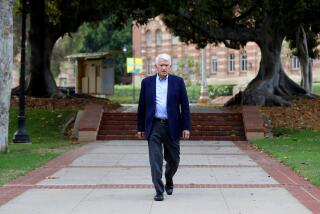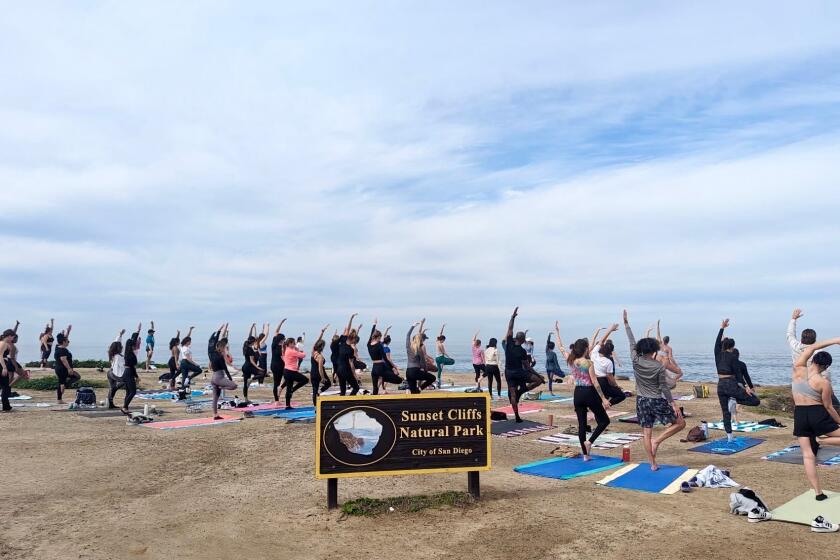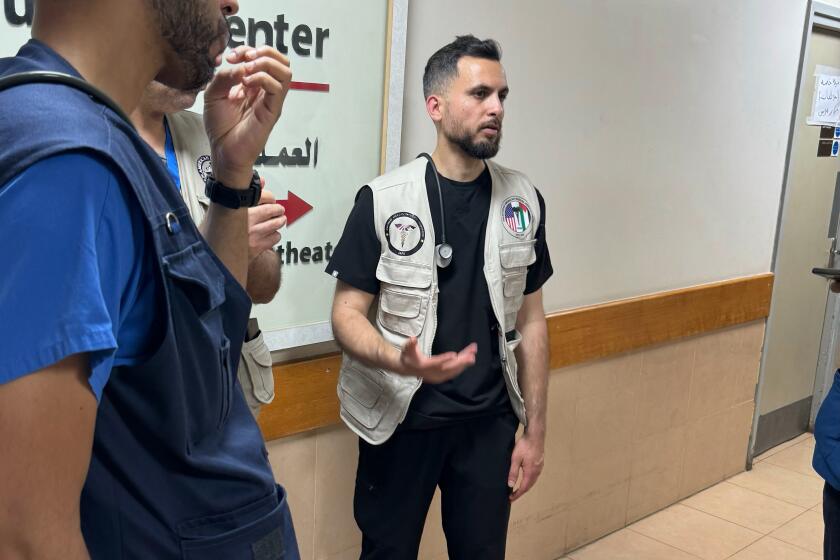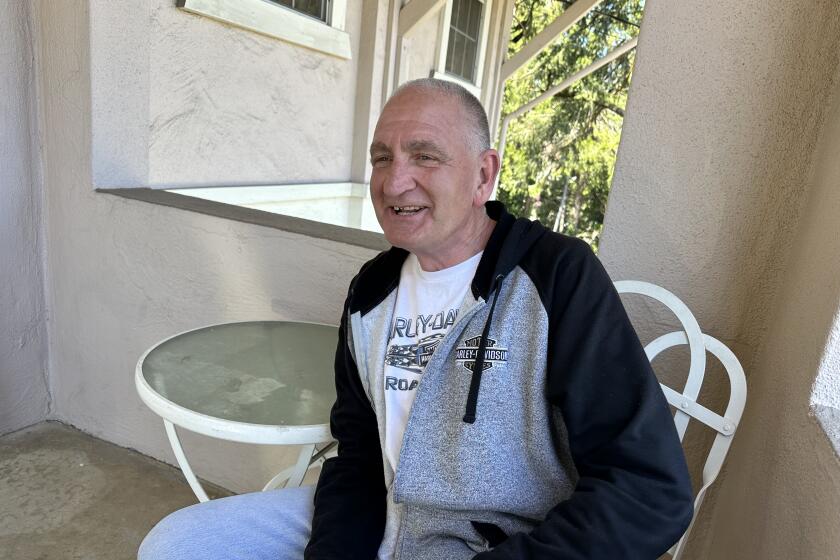Going for Broke
John Brown looks out at acres of barren California desert and sees a gambling, shopping, dining and dancing mecca.
He dreams of building as many as 15 hotels with glitzy casinos. They will encircle a promenade of 150 shops and seven “celebrity theme restaurants,” according to his printed business plan.
When completed, his gambling oasis with easy highway access will attract 20 million tourists each year, the plan declares.
And if you call now, you can get in on the action. Brown’s plan projects that for every dollar invested in his gambling center dream, there will be a return of $25. Within five years.
It’s a big dream. To try to make it come true, Brown went to the place of big dreams.
“I went to the map,” said Brown, who lives and practices law in Oxnard, “and I found California City.”
He chose it for its location. “It’s 150 miles from Los Angeles, 150 miles from the Nevada border,” Brown said. “It’s ideal.”
He wanted a place that was about a couple of hours’ drive from Los Angeles, but not in a metropolitan area.
“Nobody wants gaming in our urban areas,” said Brown. “The reason is that Joe Friday may lose his check on the way home.”
California City, located just north of the Los Angeles-Kern County line, is assuredly not urban, even though it’s huge. Geographically, California City is the third-largest city in the state, with only Los Angeles and San Diego taking up more land.
But California City has a population of only 6,000, give or take a few.
In September, Brown filed for a proposed statewide referendum to legalize gambling in California City. He is now trying to obtain the 700,000 signatures needed to get his measure on the ballot a year from this month.
If the measure passes, the City Council has agreed to grant him exclusive rights to its gambling licenses for the first three years. He will corner the California City market.
“I should be a multimillionaire if it passes,” Brown said, “and I know how to spend that money.”
*
Although Brown didn’t know it when he pointed to California City on a map, several big dreamers had already been this way, trying to bring forth riches from the desert land.
But California City is a place where big dreams come to die.
“This town gets a lot of people who come in and tell a lot of stories,” said Michael Hurles, a firefighter and California City resident who commutes daily to Edwards Air Force Base.
His wife, Tammy, has a simple bit of advice for anyone who believes the stories and dreams might be true. “Believe it the day you see it,” she said.
The first dreamer was Czechoslovakian-born sociologist Nathan K. Mendelsohn, who came to the area more than 40 years ago to try out his theories on urban development. He bought 82,000 acres--a combination of alfalfa farms and desert--in the late 1950s and created a master plan with seven communities.
He got the city incorporated, then set aside areas for light industry, a university, a medical center and an 80-acre public park to feature a 20-acre lake, outdoor swimming pool, baseball fields, golf course, tennis courts and community building.
Attracted by Mendelsohn’s dream of a new metropolis, thousands of people bought lots, most hoping to sell for high profits when the city reached its expected greatness.
But California City’s real estate market never boomed. It bombed.
Almost everyone bought purely on speculation, waiting for their neighbors to build up the neighborhood so they could sell and make a killing.
The few people who did settle in California City saw numerous plans for job-attracting industries evaporate, one by one. Shops opened and closed; lots marked off for buildings stayed vacant.
At one time there were a movie theater, bowling alley and Holiday Inn, but all shut down.
After Mendelsohn pulled out, several developers followed. At one point the famed Hunt brothers of Texas owned a stake in the city, and a Colorado mining company also took a turn. National searches were launched for industries that would come to the city and generate jobs, but it never happened.
Residents were so desperate for any source of revenue that many were thrilled eight years ago when city leaders said a state prison would be built in California City. That plan also died.
Gambling had been previously mentioned as the savior of California City. But the only organized gambling that residents ever saw, aside from church bingo, was one card room, and that shut down in the 1980s.
Most of California City’s 205 square miles of land is in the same condition it was when Mendelsohn left it in 1969--dry and brush-filled, with the occasional Joshua tree.
Squat, single-family houses and strip malls are clustered around the main street, California City Boulevard, a four-lane road that is much too wide for the traffic it carries. Side streets in this part of town sometimes end suddenly, in the middle of nowhere.
There are neither fast-food restaurants nor supermarkets. There are, however, 22 churches, although some meet in storefronts or homes.
There are two schools--one for elementary students and the other for middle grades.
“We have a master plan for a very nice community,” said City Manager Steve West. “We just need the money to build the stuff.”
Robert and Lupe Morrell bought a house on Irene Street because they wanted to retire far from the gang killings and drug sales that had become common in the Los Angeles neighborhood where they raised three kids. And homes seemed so cheap in California City.
“I paid $95,000 for this house and I can’t get $65,000 on it now,” said Robert Morrell, 73. “I have to die here.”
In the last two years, only one new residential building permit has been issued, city officials said.
Lillian “Bootsie” Evans said she’s all for gambling--or anything else that would drum up business at her tiny restaurant. “We’re hanging on by our nails, month to month,” said Evans, 64, who bought the Aspen Grill restaurant on California City Boulevard last spring. “We keep hoping something big’s going to come, like a grocery store.”
David Romero, the director of religious education at Our Lady of Lourdes Catholic Church in California City, also backs casinos coming to town. Romero, 30, said he commutes from Bakersfield because California City offers so little to a single guy.
“I think that would be great,” he said of the proposed gambling. “But at the same time I think to myself: ‘That’s a pipe dream. Who’s going to put 14,000 hotel rooms in this city?’ ”
Brown and his business partner, Robert Wilson, a retired concrete contractor from Studio City, have been trying to legalize gambling somewhere since 1964, when they worked on a failed lottery initiative.
They went on to file for nearly two dozen more lottery and gambling referendums in California and other states, none of which passed.
In 1982, Wilson was arrested and sent to jail for a few days for operating illegal bingo games in an effort to fund a gambling initiative he was pushing in the town of Adelanto in San Bernardino County.
Brown is now 71. Wilson won’t tell his age, saying that he doesn’t remember.
“We’ll do it this time,” Wilson said of their effort to bring gambling to California City. “We have to. It’s the last time.”
But it won’t be easy. Mounting the campaign to get the 700,000 signatures will cost $1 million, according to Robert Fill, Brown’s longtime friend and chief operating officer of Brown’s newly formed corporation, California City Gaming Inc.
Fill, a Washington, D.C.-based consultant for start-up businesses, said he’s hoping to put together the funds from 20 or so investors or possibly through selling stock.
So far, he’s had no luck.
“We’ve got a lot of bites, but it’s not easy,” Fill said. “The key is to be able to convince people that [the proposition] will pass.”
*
Even if the group gets the signatures, Las Vegas casino owners would likely work to defeat the ballot proposition, said Bill Thompson, a professor at the University of Nevada, Las Vegas, who studies the gambling industry.
Not only would Brown have to battle Nevada money, he’d also have to change the minds of California voters, who have historically been cold to the idea of casinos.
Many may subscribe to Atty. Gen. Dan Lungren’s way of thinking.
“He’d just as soon see gambling in Nevada and not here,” said Matt Ross, a spokesman in Lungren’s office. “It’s fun once in a while but it’s not necessarily something you want in your own backyard.”
If the proposed referendum gets on the ballot, a campaign would take tens of millions of dollars more.
And the cost of building the casinos? Don’t even ask.
But dreaming costs nothing at all.
“He’s just going through the desert,” Thompson said of Brown, “trying to kick that bucket over and find a nugget.
“And gambling is his nugget.”
(BEGIN TEXT OF INFOBOX / INFOGRAPHIC)
California City Facts
* Started: 1965, with 617 residents
* Location: 150 miles northeast of downtown Los Angeles
* Size: 205 square miles, third largest city in state
* Development: 10 square miles
* Population: 8,000
More to Read
Start your day right
Sign up for Essential California for news, features and recommendations from the L.A. Times and beyond in your inbox six days a week.
You may occasionally receive promotional content from the Los Angeles Times.





